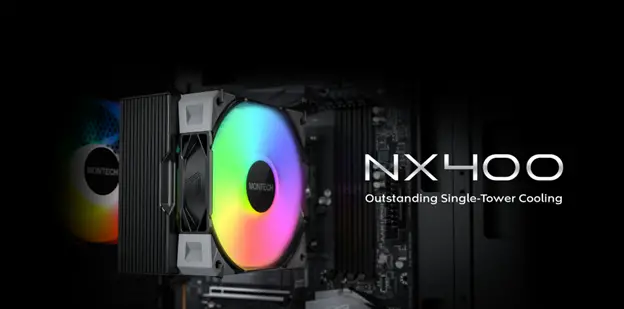The X870E and X870 chipset motherboards are excellent companions for the Ryzen 9000 series desktop CPUs but come with a hefty price tag. While pairing the Ryzen 9000 series with existing AMD 600 series chipset motherboards is an option, it doesn’t fully leverage the capabilities of the new CPUs. Thankfully, AMD has introduced the more budget-friendly B850 chipset motherboards. These are perfect for users looking to upgrade to Ryzen 9000 series CPUs without needing the premium features of the X870E and X870 chipsets.
In this quick review, we’re taking a closer look at the ROG Strix B850-A Gaming WiFi from ASUS. With its competitive feature set and stylish design, let’s see if this motherboard is worth considering for your next build.
Unboxing




The ROG Strix B850-A Gaming WiFi comes in a sleek white package reminiscent of the ROG Z890 APEX. The box highlights the motherboard’s design, key specifications, and standout features.
Inside, you’ll find the standard accessories: a user manual, WiFi antenna, ROG keychain strap, M.2 standoffs, rubber covers for onboard fan headers, and a few extra zip ties.


The B850-A Gaming WiFi immediately stands out with its full white PCB and silver heatsinks on the VRMs and M.2 SSD slots, aligning perfectly with the growing trend of white-themed PC builds. ASUS’s decision to introduce a white variant in the B850 lineup is a commendable move, offering more aesthetic options for users seeking a clean, modern look for their systems




Beyond its striking appearance, the motherboard is packed with user-friendly features typically reserved for higher-end boards. Quality-of-life additions like M.2 Q-Release, M.2 Q-Slide, M.2 Q-Latch, and Q-Release Slim simplify installation and maintenance, making this board a strong contender for mainstream builders. ASUS’s thoughtful inclusion of these features on a mid-range board is commendable, as this helps enhance the user experience without breaking the bank.
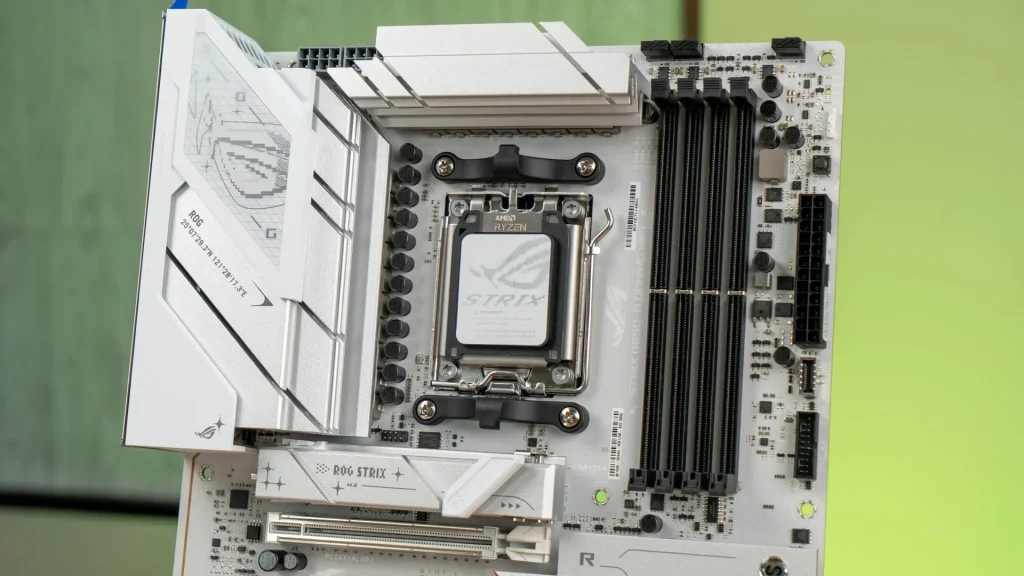
While the ROG Strix B850-A Gaming WiFi supports up to 192GB of memory across its four DIMM slots, fully populating them may limit your ability to achieve high frequencies like DDR5-7000+ or beyond. This is a common challenge, even for premium boards like the X870E Hero, where memory performance tends to be better with two DIMMs instead of four.
Achieving extreme speeds, such as DDR5-8000+ with all slots populated, is unlikely due to the increased strain on memory signal integrity. For best results, stick to a dual-DIMM configuration if high-frequency performance is a priority.
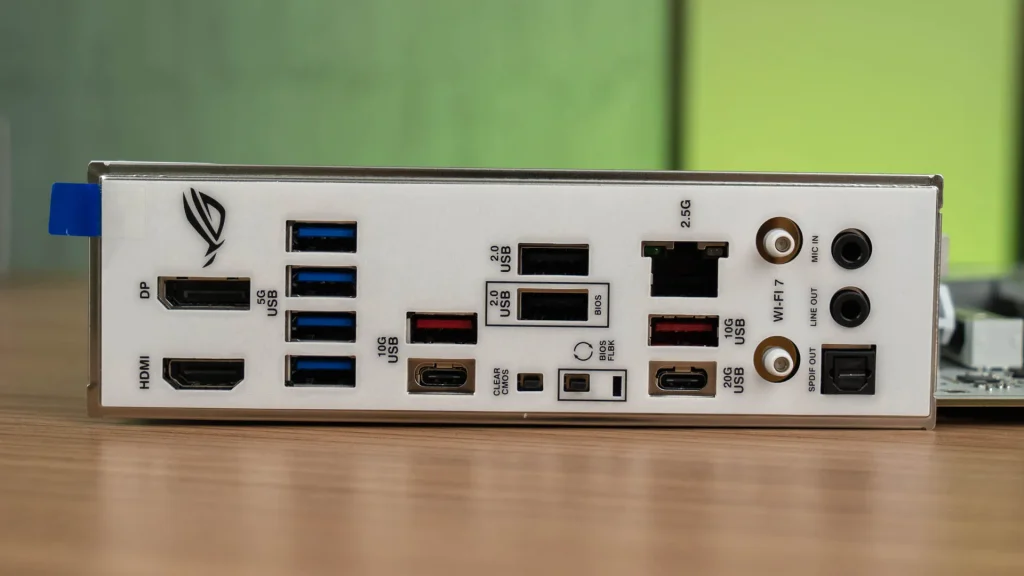
he rear I/O on the B850-A Gaming WiFi offers a solid range of connectivity options, surpassing its predecessor in functionality. However, the layout of the USB ports and the placement of the CMOS clear and BIOS flashback buttons feel less intuitive compared to the more organized arrangement on the X870E Hero. While not a dealbreaker, it’s an area that could have been better executed.
That said, the inclusion of 4 USB 3.2 Gen1 ports is a welcome feature, offering faster transfer speeds for flash drives, alongside 2 USB 2.0 ports reserved for peripherals. The slight compromise of having one less USB 3.2 Gen2 Type-A port is manageable for most users. On the networking side, the board impresses with a 2.5GbE Ethernet port and WiFi 7, delivering fast and reliable connectivity that aligns well with the needs of mainstream and advanced users alike.
Test system list
| CPU | AMD Ryzen 9 9900X |
| Motherboard | ASUS ROG Strix B850-A Gaming WiFi |
| Memory | KLEVV CRAS V RGB DDR5 (16GB x2) |
| Graphics Card | GeForce RTX 3080 10G |
| Power Supply | Cooler Master M2000 Platinum 2000W |
| Primary Storage | Kingston KC3000 2TB |
| Secondary Storage | PNY XLR8 CS3040 2TB |
| CPU Cooler | Deepcool LS720 AIO Liquid Cooler |
| Chassis | Streacom Open BenchTable |
| Operating System | Windows 11 Pro 24H2 |
CPU load test and thermals
In our quick evaluation, we paired the Ryzen 9 9900X with the B850-A Gaming WiFi to assess its performance. The Ryzen 9 9900X draws around 150 to 160W on this board, which is well-handled by the robust VRM design, making it a suitable choice for high-performance processors like this one.
Despite a built-in thermal limit that caps temperatures at 95°C under load, the board allows for fine-tuning options to optimize performance according to your needs—an advantage AMD continues to provide on B850 chipset motherboards. For cooling, we used the Deepcool LS720 AIO liquid cooler, which performed admirably and proved sufficient for keeping the Ryzen 9 9900X in check at stock settings.
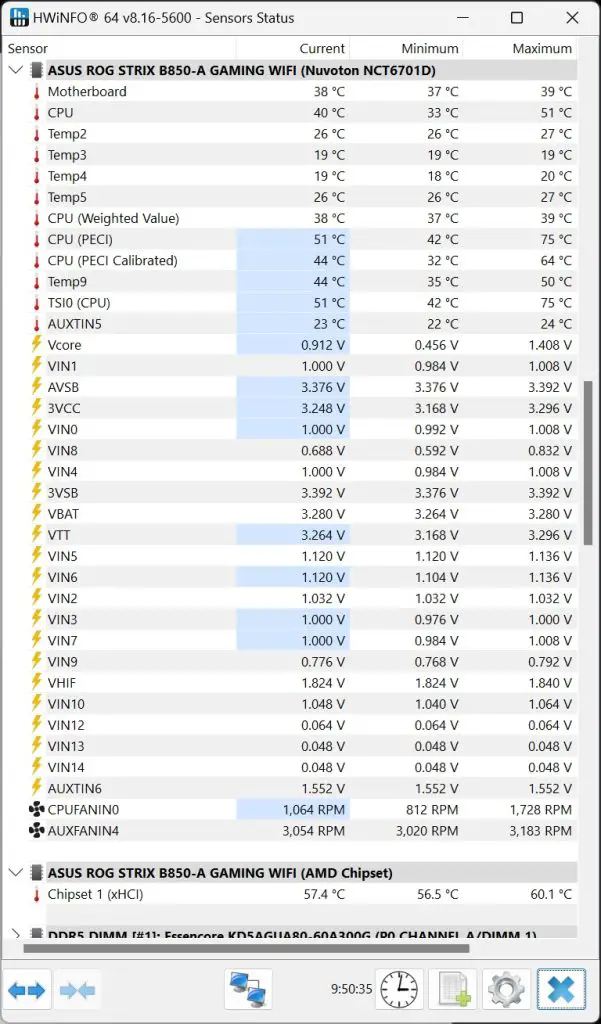
The load test was conducted with the CPU running at stock settings, and temperature readings from the motherboard and chipset sensors were recorded for analysis. Although VRM temperature data wasn’t available via HWinfo64, the chipset temperature peaked at a manageable 60°C during load, staying well within acceptable limits.



To gain more insight, we used a thermal imaging camera to inspect the VRM and chipset heatsink regions under load. The thermal images revealed that the VRM heatsink maintained impressively low temperatures, barely exceeding 50°C throughout the stress test. Overall, the temperatures remained stable even during extended periods of heavy usage, and no major issues were encountered during other benchmark sessions.
Memory overclocking
When it comes to memory overclocking, AMD continues to recommend DDR5-6000 with a 1:1 UCLK to MCLK ratio as the sweet spot, even with the Ryzen 9000 series CPUs. However, with the improved memory controller on these processors, achieving DDR5-6400 with the same 1:1 ratio is now more accessible.
As seen with X870E chipset boards, the B850-A Gaming WiFi also managed DDR5-6400 CL30 on a 1:1 ratio with ease, making it an enticing option for users aiming to extract better performance. While memory overclocking can be a bit daunting for beginners, the results are well worth the effort.
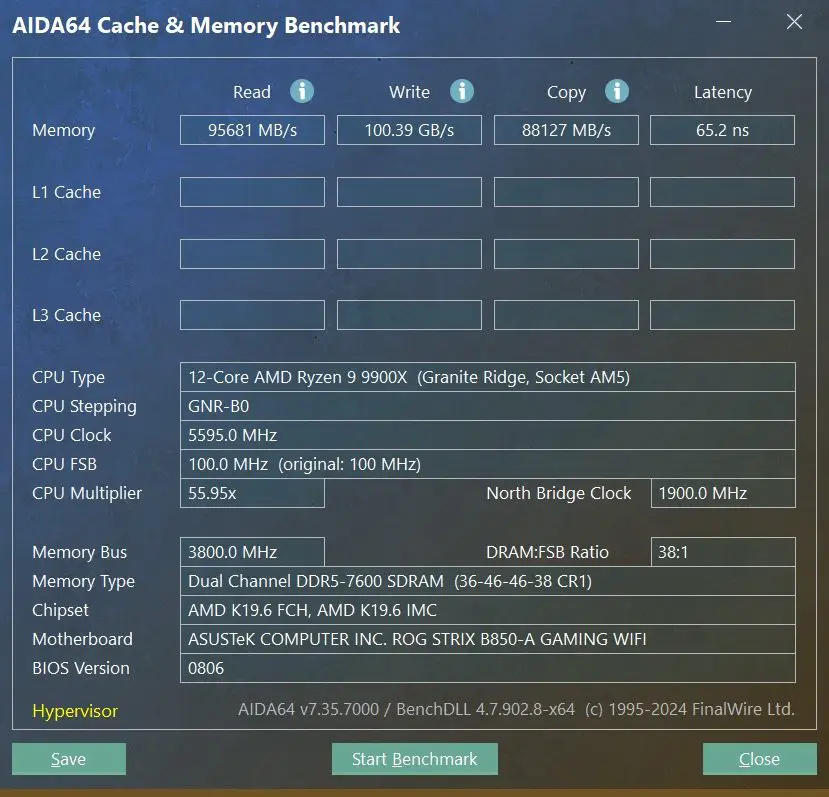
For enthusiasts eyeing DDR5-8000+ performance, it’s important to understand that such speeds operate on a 1:2 UCLK to MCLK ratio. Noticeable gaming performance gains typically require DDR5-8266 or higher, which can be challenging without a kit designed for EXPO DDR5-8000+. While we attempted DDR5-8000 on the B850-A Gaming WiFi, the effort required was noticeably higher than on X870E chipset boards, even with the same CPU and memory kit.
However, we successfully ran the KLEVV CRAS V RGB DDR5 kit at DDR5-7600 using BIOS memory presets, with minor voltage tweaks and slightly relaxed tRFC timings. This configuration passed stress tests like Karhu RAM Test and BenchMate benchmarks, demonstrating solid overclocking potential for this mid-range motherboard.
Thoughts on the ROG Strix B850-A Gaming WiFi
Despite the rather high price of RM 1,469, B850-A Gaming WiFi stands out on the quality-of-life (QOL) enhancements that make it a significant step forward, particularly for a mid-range motherboard. These features, often reserved for higher-end models like the X870E, elevate the user experience, making the board more accessible and convenient for builders of all levels.
In addition to a solid specifications upgrade, the B850-A Gaming WiFi offers impressive storage options, slightly surpassing its predecessor, the B650-A Gaming WiFi. However, users should note that the PCIe X16_2 slot and M.2_3 slot share lanes, meaning the M.2_3 slot will be disabled if the PCIe X16_2 slot is used.
Overall, the B850-A Gaming WiFi is a reliable and well-rounded motherboard for those planning to build a new system with AMD Ryzen 9000 series desktop processors.











